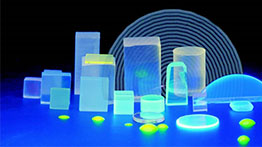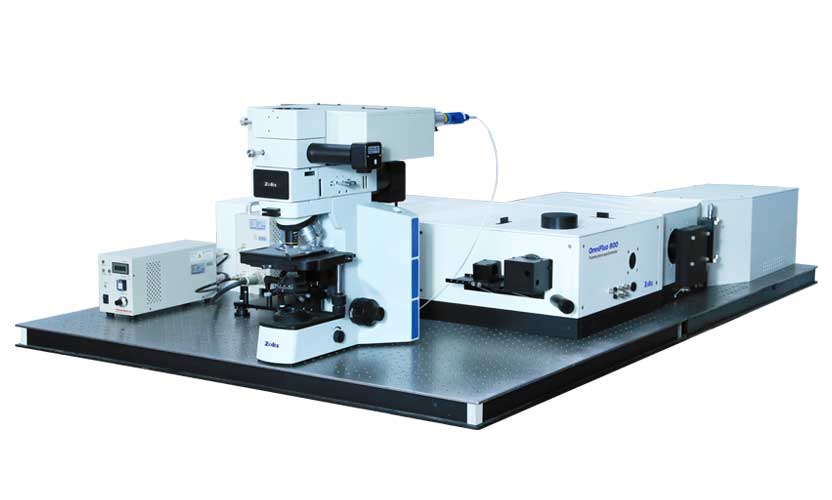
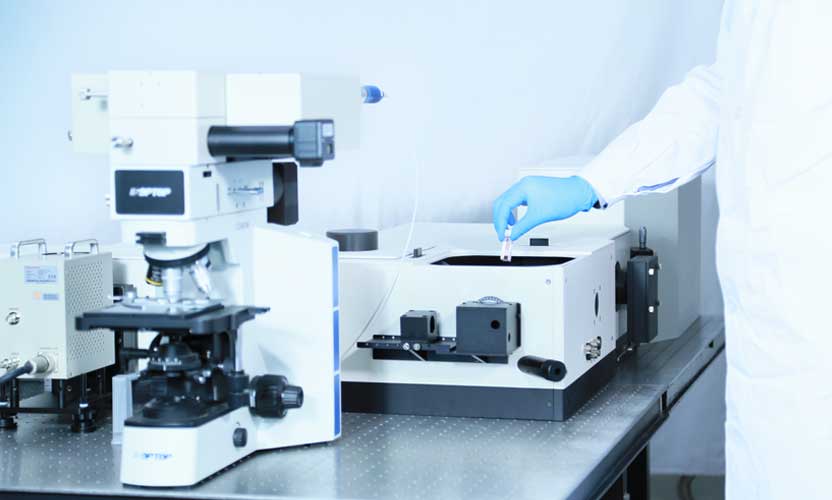
OmniFluo900 series Fluorescence Spectrometers
Fluorescence is the light emitted by matter after absorbing light or other electromagnetic radiation. When light is irradiated to some atoms, the energy of light makes some electrons around the nucleus from the original energy level to a higher energy level, that is, from the ground state to the first excited single or second excited singlet states. The first excited single or second excited singlet states are unstable, so the ground state will be restored. When the electron is recovered from the first excited single state to the ground state, the energy will be released in the form of light, that is, to produce fluorescence.
Features:
The OmniFluo900 series is a high-performance, versatile, modular fluorescence spectrometer for research applications in material science, physics, chemistry, life sciences and agricultural science.
This system provides both steady-state and lifetime measurement. It can be configured for spectral measurements from the ultraviolet to the infrared and for lifetime measurements ranging from hundreds of picoseconds to seconds.
The instrument features extraordinary sensitivity and exceptional stray light suppression, which is very important for the detection of weak fluorescence. Its signal-to-noise ratio (SNR) for the Raman scattering of water – an index commonly used to represent the sensitivity of a fluorescence spectrometer – can reach or exceed 10,000:1.
Optional microscope and a cryostat can be added to achieve high spatial resolution and temperature-dependent measurement.
Main features
• Modular design for maximum flexibility and extendibility;
• A water Raman SNR greater than 10,000:1;
• Large spectral coverage ranging from UV to MIR (200nm ~ 5500nm);
• Excellent stray light suppression;
• Multiple light sources and detectors are available; optional double-monochromator configuration;
• Intuitive software for steady-state and time-resolved measurements with lifetime fitting function
Spectrometer configuration


Sample chamber
At the heart of the OmniFluo900 there is a large sample chamber that features a dedicated design for best results . Large-aperture fused silica lenses provide highly efficient excitation and emission collection. A filter holder in the emission arm can accommodate 50mm×50mm or 25mm×25mm filters, allowing the user to select low-pass, high-pass or band-pass filters for special purposes.
• A laser can be directed into the sample chamber through a side port. A variable. neutral-density filter is used to control the power of the laser
• Standard sample holders: cuvette, bulk/ powder/ film clamps;
• Optional rotating stage; magnetic stirrer; temperature-controlled or -regulated stage
• Optional software-controlled polarizers for fluorescence anisotropy
• Optional cryostat: 77–500K, 3–300K



Basic features
Spectral correction
Spectral correction accounts for all instrumental effects, such as those from mirrors, light sources and detectors, to obtain the true excitation and emission spectra. Spectral correction, using factory-measured correction files, is a standard operating procedure for the OmniFluo900 series.
The figure below shows the calibration curves of grating
G1 and grating G2 of the emission monochromator.
G1-1200g/mm, 300nm blaze wavelength
G2-1200g/mm, 500nm blaze wavelength

The yellow line in the figure below shows the original (not corrected) spectrum, and the blue line shows the corrected one. The peak has 10nm red shift in the corrected spectrum compared to the raw data.

The calibration spectrum can reflect the sample’s true luminescence condition, for example the true position of the peak. For samples with multiple emission peaks, the corrected spectrum more accurately shows the relative intensity relationship between these emission peaks.
Exceptional sensitivity
Thanks to the OmniFluo900 series’ single-photon counting technique, its high-quality optical pathways, the dedicated and optimized light sources and its ultra-sensitive detectors, the instrument’s water Raman signal-to-noise ratio (SNR) can easily reach 10,500:1.
Rather than employing complicated calculation procedures, we use the straightforward square-root (SQRT) method for sensitivity validation:

With a single excitation and emission monochromator, a SNR of more than 10,500:1 can easily be attained.
High resolution and high accuracy

The OmniFluo900 series uses a 320mm imaging monochromator to suppress astigmatism for excellent image quality. The wavelength adjustment is driven by a stepper motor in increments of 0.005nm. With a 1200g/mm grating, the spectral resolution is 0.08nm, the wavelength accuracy is ±0.2nm and the wavelength repeatability is ±0.1nm.
Upgrade Options
Excitation light sources

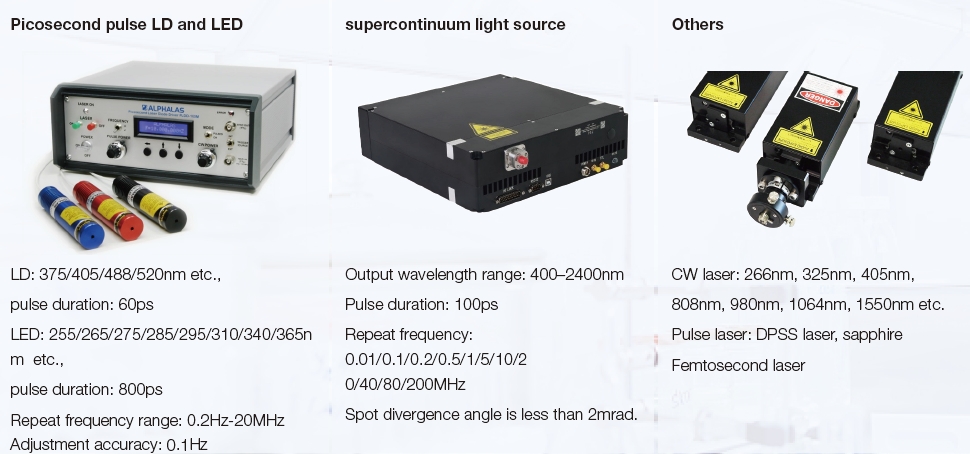
Detectors
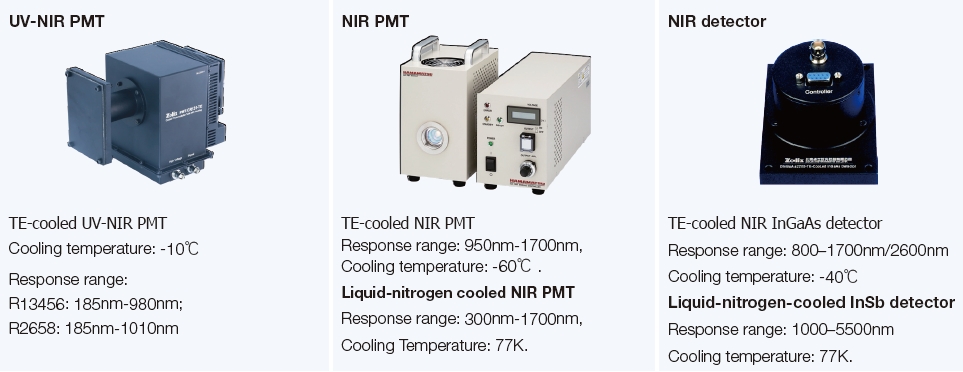
Sample holders

Cryostat

Microscopic spectrum test platform


Quantum yield accessory

Cameras
Single-photon camera

Streak camera

Infrared camera

Hyperspectral camera

Hyperspectral microscope system
An Omni-Image push-broom hyperspectral camera is mounted on the microscope to realize various spectrum tests at microscale. Excitation light source: 385nm LED parallelized illumination Objective lens: 20×
Spectral resolution: 3.5nm
Spectral range: 400–1000nm CCD
Integration time: 300ms CCD gain: 5×
CCD pixel: 696×256

The following figure extracts the monochromatic image at 610nm and the spectrum at different positions.

The following figure shows the full spectrum image after IPCA processing.



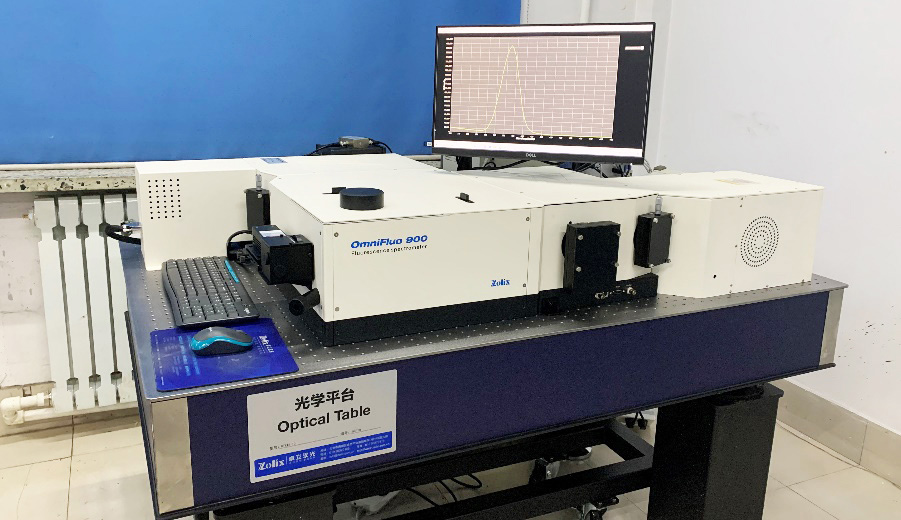


| System performance | |
| Spectral range | Emission spectrum: 200–870nm, excitation spectrum: 200–800nm |
| Spectral resolution | 0.08nm@435.84nm |
| Water Raman SNR ① | >10,500:1 |
| Lifetime range | MCS: 10口s-10s, TCSPC: 500ps-ns-口s-2.2s |
| Extended function | Multiple excitation sources, infrared spectrum test, temperature-dependent spectrum test, microscopic spectrum test, quantum yield measurement |
| Excitation light Source | |
| Xenon arc source | Power: 75W, output spectral range: 200nm-1800nm, lamp cup design, coupling efficiency better than 90% |
| Pulse light source | Microsecond pulse xenon flashlamp, picosecond pulse laser, picosecond pulse LED, supercontinuum source, OPO wavelength tunable nanosecond laser, etc. |
| Optional light source | CW laser: such as 808nm, 980nm laser, X-ray tube, lamp pumped nanosecond DPSS laser. |
| Spectrometer | |
| Optical design | Czerny-Turner |
| Specification ② | Focal length: 320mm, stray light: 1*10-5, spectral resolution: 0.08nm, wavelength accuracy: ±0.2nm, wavelength repeatability: ±0.1nm |
| Grating | Excitation grating: 1200g/mm at 300nm blaze wavelength, 600g/mm at 500nm blaze wavelength Emission grating: 1200g/mm at 500nm blaze wavelength, 600g/mm at 750nm blaze wavelength, 300g/mm at 1250nm blaze wavelength |
| Sample chamber | |
| Sample holders | Standard: liquid, powder and film holders; optional: rotating sample holder, magnetic stirring sample holder, water-bath heated sample holder |
| Detector protection | Automatically blocks the light once the cover is removed. |
| Detector | |
| PMT | Standard: TE-PMT-CR131: 185-900nm |
| Optional: TE-PMT-R13456: 185-980nm, TE-PMT-R2658: 185-1010nm, TE-PMT-H10330C-75: 950– 1700nm, LN-PMT-R5509-73: 300–1700nm |
|
| Optional analog detector | TE-InGaAs: 800–1700nm or 800–2600nm, LN-InSb: 1000–5500nm |
| Data acquisition system | |
| Photon counter | Single-photon counter: counting rate: 100Mcps, sampling speed: 1MB/s, four-channel analog input: 1–10V, AD: 16bits |
| Time correlation single photon counter |
Counting rate: 100Mcps, resolution: 16/32/64/128/256/512/1024ps, channel: 65535 |
| Lock-in amplifier | Frequency range: 50mhz–120khz, dynamic reserve: >100db, gain |
| Software | |
| Control software | spectral acquisition modes: excitation scan, emission scan, synchronous scan,3D scan Lifetime acquisition modes:kinetic scan, lifetime scan, TRES scan Data processing: Quantum yield, TRES slicing, Spectrum calibration Optional function:Anisotropy scan, Temperature dependant scan |


